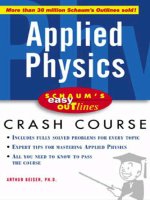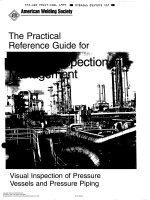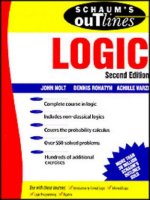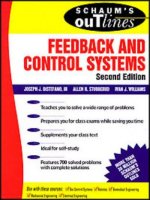Outline of Guide for Application of Transmission Line Surge Arresters 42 to 765 kV
Bạn đang xem bản rút gọn của tài liệu. Xem và tải ngay bản đầy đủ của tài liệu tại đây (3.62 MB, 128 trang )
Effective December 6, 2006, this report has been made publicly available in
accordance with Section 734.3(b)(3) and published in accordance with
Section 734.7 of the U.S. Export Administration Regulations. As a result of
this publication, this report is subject to only copyright protection and does
not require any license agreement from EPRI. This notice supersedes the
export control restrictions and any proprietary licensed material notices
embedded in the document prior to publication.
Outline of Guide for Application of Transmission Line
Surge Arresters—42 to 765 kV
Extended Outline
1012313
Outline of Guide for Application of Transmission Line
Surge Arresters—42 to 765 kV
Extended Outline
1012313
Technical Update, October 2006
EPRI Project Manager
A. Phillips
ELECTRIC POWER RESEARCH INSTITUTE
3420 Hillview Avenue, Palo Alto, California 94304-1338 . PO Box 10412, Palo Alto, California 94303-0813 . USA
800.313.3774 . 650.855.2121 . . www.epri.com
DISCLAIMER OF WARRANTIES AND LIMITATION OF LIABILITIES
THIS DOCUMENT WAS PREPARED BY THE ORGANIZATION(S) NAMED BELOW AS AN
ACCOUNT OF WORK SPONSORED OR COSPONSORED BY THE ELECTRIC POWER RESEARCH
INSTITUTE, INC. (EPRI). NEITHER EPRI, ANY MEMBER OF EPRI, ANY COSPONSOR, THE
ORGANIZATION(S) BELOW, NOR ANY PERSON ACTING ON BEHALF OF ANY OF THEM:
(A) MAKES ANY WARRANTY OR REPRESENTATION WHATSOEVER, EXPRESS OR IMPLIED, (I)
WITH RESPECT TO THE USE OF ANY INFORMATION, APPARATUS, METHOD, PROCESS, OR
SIMILAR ITEM DISCLOSED IN THIS DOCUMENT, INCLUDING MERCHANTABILITY AND FITNESS
FOR A PARTICULAR PURPOSE, OR (II) THAT SUCH USE DOES NOT INFRINGE ON OR
INTERFERE WITH PRIVATELY OWNED RIGHTS, INCLUDING ANY PARTY'S INTELLECTUAL
PROPERTY, OR (III) THAT THIS DOCUMENT IS SUITABLE TO ANY PARTICULAR USER'S
CIRCUMSTANCE; OR
(B) ASSUMES RESPONSIBILITY FOR ANY DAMAGES OR OTHER LIABILITY WHATSOEVER
(INCLUDING ANY CONSEQUENTIAL DAMAGES, EVEN IF EPRI OR ANY EPRI REPRESENTATIVE
HAS BEEN ADVISED OF THE POSSIBILITY OF SUCH DAMAGES) RESULTING FROM YOUR
SELECTION OR USE OF THIS DOCUMENT OR ANY INFORMATION, APPARATUS, METHOD,
PROCESS, OR SIMILAR ITEM DISCLOSED IN THIS DOCUMENT.
ORGANIZATION(S) THAT PREPARED THIS DOCUMENT
Kinectrics North America, Inc.
NOTE
For further information about EPRI, call the EPRI Customer Assistance Center at 800.313.3774 or
Electric Power Research Institute and EPRI are registered service marks of the Electric Power
Research Institute, Inc.
Copyright © 2006 Electric Power Research Institute, Inc. All rights reserved.
CITATIONS
This report was prepared by
Kinectrics North America Inc.
800 Kipling Avenue
Toronto, Ontario, Canada
Principal Investigator
W.A. Chisholm
This report describes research sponsored by the Electric Power Research Institute (EPRI).
This publication is a corporate document that should be cited in the literature in the following
manner:
Outline of Guide for Application of Transmission Line Surge Arresters—42 to 765 kV: Extended
Outline. EPRI, Palo Alto, CA: 2006. 1012313.
iii
PRODUCT DESCRIPTION
Lightning flashovers are the most frequent cause of transmission line outages. Transmission line
surge arresters (TLSA) limit lightning overvoltages between phase conductors and towers, and
thus eliminate most outages on protected structures. This guide provides a tutorial on the relevant
lightning phenomena, with an in-depth look at the operation, application, and placement of
TLSA to maximize flashover protection and minimize capital investment. The guide also
describes ways to improve tower grounding for better performance of overhead groundwires.
Results and Findings
The guide contains an in-depth description of the following areas:
•
The parameters that influence transmission line lightning performance / parameters.
Lightning incidence scales performance in all regions. With overhead groundwires, lightning
currents act against local soil resistivity to create insulator stress. Adding arresters reduces
the influence of grounding. When OHGW are removed, leaving only arresters, the lightning
charge replaces peak current as a dominant stress. The section also discusses other
transmission line features that affect line lightning performance, including line, tower,
insulator and arrester air gap geometries; tower impedance; and nonlinear corona effects.
•
TLSA selection/specification. Before selecting a TLSA, utility engineers should consider a
number of design questions concerning arrester operating characteristics and rating,
temporary overvoltages, arrester protective levels and insulation coordination, TLSA energy
capability, arrester failures, TLSA housings, and TLSA installation and handling. Selecting
an arrester system (possibly including a series gap or insulator) for a particular transmission
line is the process of simultaneously satisfying these concerns with a single arrester type.
•
Placement of arresters for improved lightning performance. The efficient application of
TLSA to improve line performance requires the investigation of all available mitigation
options and weighing of the performance benefits against real cost. Estimating the effects of
changes in tower structure and design, shielding, grounding, and arresters on the lightning
performance of transmission lines is crucial to this process. This section discusses backflashover protection, unshielded applications, and transmission lines over varying terrain.
Challenges and Objectives
One difficulty in focusing this report is the wide range of technical backgrounds of the readers.
Electrical engineers will be most interested in insulation coordination and risk management.
Civil engineers will be more interested in what will be gained and lost if a new line is designed
without overhead groundwires (OHGW) and with compact insulation, protected by TLSA. While
v
these readers will find what interests them, the main focus of this report is a utility project
manager facing a decision to replace existing overhead groundwires (OHGW), the fastestdecaying transmission line component, with a typical life of 25 to 55 years. What has changed in
ten years is that the decision to put up TLSA in place of OHGW is commercially and technically
viable in many areas. Having this new alternative, with its reduced visual impact and peak-load
loss reduction, can help the utility bottom line, especially considering that the OHGW
conductors represent 4% of the total line investment.
Applications, Values, and Use
New lines with reduced visual impact are already taking advantage of TLSA to replace overhead
groundwires. So far, these applications have been made in areas of difficult grounding and low
lightning incidence. However, the alternative of buried transmission cable looms like the sword
of Damocles, motivating overhead line engineers to deliver more reliability with fewer resources.
EPRI Perspective
Lightning causes power outages that cost utilities more than $1 billion per year directly, in
damaged or destroyed equipment. The indirect damage to customers from all power quality
problems is estimated to exceed $100 billion per year, with more than half of these disturbances
having lightning as a root cause. This guide presents TLSA theory and design information to
enable utilities to minimize the number outages due to lightning. EPRI developed this guide with
the understanding that users may not be familiar with either TLSA or the current standards that
do, or should, apply to them. The guide is tutorial in nature and does not anticipate every
situation or utility need. In general, however, experience has shown that properly designed,
installed, inspected, and maintained hardware such as TLSA, counterpoise, and overhead
groundwires can significantly improve system reliability and power quality.
Approach
In 1997, EPRI delivered a TLSA application guide (TR-108913), consolidating literature with
results of a survey of 31 EPRI-member utilities. EPRI also supported arrester energy and
mechanical tests at the EPRI Power Delivery Center-Lenox.
The state of the art of TLSA has advanced considerably since the last EPRI guide was published.
Line arresters have proved themselves as technically and economically feasible for improving
performance of conventional lines with overhead groundwires. TLSA have also been used on
230-kV and 400-kV lines without overhead groundwires, where the extra surge duties raise new
electrical reliability concerns. Most of the difficulties found in applying TLSA relate to the
spotty reliability of mechanical components. This can be addressed by ensuring that TLSA
components meet the same high reliability standards that apply to other line components.
This document is an extended outline that will be built upon and refined over the new few years
to develop a completed guide
Keywords
Reliability
Lightning and weather impacts
Power quality
Transmission lines
vi
ABSTRACT
In most areas, flashovers from lightning are by far the most frequent cause of transmission line
outages. Transmission line surge arresters (TLSA) limit the lightning over-voltages between
phase conductors and the tower structure. This prevents flashovers and insulation damage on
that structure. This guide provides a tutorial of the relevant lightning phenomena, in general, and
offers an in-depth look at the operation, application, and placement of TLSA to maximize
flashover protection and minimize capital investment.
The guide also considers other mitigation measures, including improved tower grounding and the
application of overhead groundwires. EPRI developed this guide with the understanding that
users may not be familiar with either TLSA or the current standards that do or should apply to
them. The guide, therefore, is tutorial and does not anticipate every situation or utility need.
Overall, however, experience has shown that properly designed, installed, inspected, and
maintained hardware such as TLSA, counterpoise, and overhead groundwires can significantly
improve system reliability and power quality.
This document is an extended outline that will be built upon and refined over the new few years
to develop a completed guide
i
CONTENTS
1 PURPOSE ..............................................................................................................................1-1
2 DEFINITIONS .........................................................................................................................2-1
3 WHY PROTECT TRANSMISSION LINES FROM LIGHTNING .............................................3-1
Economic Impact of Power Quality Problems .......................................................................3-1
Classification of Power Quality Problems..............................................................................3-1
Lightning as a Root Cause of Short-Duration Faults.............................................................3-3
Typical Power Line Lightning Mitigation Options...................................................................3-4
Utility Investment in Lightning Protection using Overhead Groundwires...............................3-4
Utility Investment in Other Lightning Protection Methods......................................................3-5
4 TRANSMISSION LINE LIGHTNING PERFORMANCE PARAMETERS ...............................4-1
Introduction ...........................................................................................................................4-1
Lightning Incidence Parameters............................................................................................4-2
Ground Flash Density (GFD)............................................................................................4-2
Lightning Incidence to Lines .............................................................................................4-4
Lightning Current Parameters ...............................................................................................4-8
Stroke Current Peak Magnitudes .....................................................................................4-9
Stroke Current Rate of Rise ...........................................................................................4-11
Stroke Current Waveshapes ..........................................................................................4-12
Total Charge Delivered...................................................................................................4-13
Number of Strokes in a Flash .........................................................................................4-14
Transmission Line Parameters............................................................................................4-14
Line Conductor Geometries............................................................................................4-15
Tower Geometries ..........................................................................................................4-15
Insulator / Air Gap Geometries .......................................................................................4-16
Volt-Time Curve Penetration Method.........................................................................4-18
ix
Disruptive Index Method ............................................................................................4-18
Leader Progression Method.......................................................................................4-19
Tower Ground Characteristics........................................................................................4-19
Buried Tower Grillage ................................................................................................4-20
Driven Ground Rods ..................................................................................................4-20
Counterpoise .............................................................................................................4-20
Transmission Line Surge Arresters (TLSA)....................................................................4-21
Nonlinear Corona Effects ...............................................................................................4-21
5 TLSA SELECTION AND SPECIFICATION ...........................................................................5-1
Introduction ...........................................................................................................................5-1
Transmission Line Arresters..................................................................................................5-1
Arrester Operating Characteristics ........................................................................................5-5
Arrester Rating and MCOV ...................................................................................................5-7
Temporary Overvoltages.......................................................................................................5-7
Arrester Protective Levels and Insulation Coordination ........................................................5-8
Lightning Insulation Coordination .....................................................................................5-9
Switching Surge Insulation Coordination........................................................................5-11
Energy Capability of TLSA ..................................................................................................5-12
Lightning Energy.............................................................................................................5-12
Switching Energy............................................................................................................5-13
Arrester Failures..................................................................................................................5-15
Electrical Failure Modes .................................................................................................5-15
Arrester Disconnects ......................................................................................................5-16
TLSA Housings ...................................................................................................................5-18
TLSA Installation and Handling ...........................................................................................5-19
Handling and Installation Recommendations ......................................................................5-20
Handling .........................................................................................................................5-20
Installation and Maintenance..........................................................................................5-20
Arrester Markings ...........................................................................................................5-20
6 PLACEMENT OF ARRESTERS FOR IMPROVED LIGHTNING PERFORMANCE..............6-1
Economics.............................................................................................................................6-1
Backflashover Protection.......................................................................................................6-1
Phase Location of TLSA...................................................................................................6-1
x
Coupling to Overhead Groundwires.............................................................................6-1
Crossarm Voltage ........................................................................................................6-3
TLSA Location for High Tower Footing Resistance..........................................................6-4
Unshielded Applications ........................................................................................................6-5
Arrester Energy ................................................................................................................6-6
Vertical Circuits.................................................................................................................6-6
Horizontal Circuits ............................................................................................................6-8
Transmission Lines over Unchanging Terrain.......................................................................6-9
Compact Transmission Lines ..............................................................................................6-11
Compact Transmission Lines with Overhead Groundwires and TLSA...........................6-11
Compact Unshielded Transmission Lines with TLSA.....................................................6-13
7 APPLICATION SOFTWARE ..................................................................................................7-1
Introduction ...........................................................................................................................7-1
Lightning Performance Design Workstation (LPDW) ............................................................7-1
TFLASH Overview.................................................................................................................7-1
Building a TFLASH Model .....................................................................................................7-2
TFLASH Capabilities ........................................................................................................7-2
General Procedure for Constructing a Line Model ...........................................................7-2
Analyzing a TFLASH Model ..................................................................................................7-5
The Classical Solution - The Average Performance of the Line.......................................7-5
Oscillographs - Line Behavior for a User-Specified Stroke ..............................................7-6
General Procedure / Sample Application .........................................................................7-7
8 CASE STUDIES .....................................................................................................................8-1
44 kV Case Studies...............................................................................................................8-1
Comparison of OHGW versus TLSA using Customer Momentary Disturbance
Benchmark .......................................................................................................................8-1
Application Experience with 44-kV Arrester Application...................................................8-3
46 kV Case Studies...............................................................................................................8-4
66 kV Case Study .................................................................................................................8-4
69 kV Case Study .................................................................................................................8-4
115 kV Vertical Line Case Study...........................................................................................8-5
115 kV Horizontal H-Frame Line Case Study .......................................................................8-7
115 kV Horizontal Steel Lattice Line Case Study..................................................................8-8
xi
115-kV Horizontal Line: Predicted Outage Rate...............................................................8-8
115 kV Horizontal Line: Outage Rates with Partial TLSA Treatments .............................8-8
115 kV Horizontal Steel Lattice Line: Lessons Learned ...................................................8-9
138 kV Case Studies...........................................................................................................8-10
154 kV Case Study .............................................................................................................8-10
161 kV Case Studies...........................................................................................................8-10
230 kV Case Studies...........................................................................................................8-10
230 kV Horizontal Line: Application Experience.............................................................8-10
230 kV Circuit with 35-kV Underbuild .............................................................................8-11
275 kV Case Studies...........................................................................................................8-11
400 kV Case Study .............................................................................................................8-11
500 kV Case Studies...........................................................................................................8-12
765 kV Case Study .............................................................................................................8-13
9 REFERENCES .......................................................................................................................9-1
A TLSA MECHANICAL PERFORMANCE TESTS .................................................................. A-1
Line Disconnector Testing.................................................................................................... A-1
Arrester Body Testing........................................................................................................... A-2
Evaluation of Different Arrester Installation Configurations.................................................. A-2
B TLSA ENERGY WITHSTAND TEST DATA ......................................................................... B-1
Definition of Withstand Criteria............................................................................................. B-1
Tests of 63-mm TLSA to Destruction ................................................................................... B-1
Tests of 8.4-kV MCOV Samples to Thermal Runaway ........................................................ B-1
C TRANSMISSION LINE LIGHTNING PERFORMANCE CASE STUDIES ............................ C-1
D MECHANICAL FORCE ANALYSIS FOR GAPLESS TLSA INSTALLATIONS................... D-1
xii
LIST OF FIGURES
Figure 3-1 Power Quality Acceptability Curves. Left: Computer Business Equipment
Manufacturers Association (CBEMA) 1996; Right: Information Technology Industry
Council (2000)....................................................................................................................3-2
Figure 3-2 Origins of Power Quality Disturbances < Substitute EPRI figure here > [Plata
2002] ..................................................................................................................................3-2
Figure 3-3 Power System Areas where Transmission Faults will Cause 50% and 70%
Sags <EPRI Ashok Sundaram>.........................................................................................3-3
Figure 4-1 Lightning Ground Flash Density for Continental USA, 1989-1998 [Orville
Huffines] .............................................................................................................................4-3
Figure 4-2 Lightning Ground Flash Density from NALDN, 2000 to 2003 (Vaisala, need
permission).........................................................................................................................4-3
Figure 4-3 Optical Transient Density Map from (NASA 2006) and Estimate of Ground
Flash Density .....................................................................................................................4-4
Figure 4-4: Relation between Lateral Attractive Distance Da of Horizontal Conductor and
Average Conductor Height h . Curve 1: Eriksson; Curve 2: D=2h; Curve 3: Rizk.............4-5
Figure 4-5 Striking Distances from Ground and Conductor to a Downward Leader ..................4-6
Figure 4-6: Modeling of Lightning Shielding Failures using L2 Applet [Red 2005] for Peak
Stroke Currents of 5, 15 and 25 kA....................................................................................4-7
Figure 4-7 Relation between Lightning Leader Potential and Stroke Charge [Mazur 2001] ......4-8
Figure 4-8 Lightning to Instrumented Rods on Tokyo Electric Transmission Towers
[Takami 2005] ..................................................................................................................4-10
Figure 4-9 Relation between Maximum Rate of Rise and Peak Amplitude of Lightning to
Tokyo Electric Transmission Towers [Takami 2006]........................................................4-11
Figure 4-10 Relation between “Virtual Front Time” and First Peak Amplitude for Lightning
to Tokyo Electric Towers [Takami 2006] ..........................................................................4-12
Figure 4-11 Percentage of Positive Cloud-to-Ground Lightning Flashes (Left) and
Density of Large-Amplitude Positive Flashes (Right) in USA [Boccippio et al .................4-14
Figure 4-12 Flashover paths for a V-String Configuration .......................................................4-17
Figure 5-1 Internal Construction of Silicon Carbide Lightning Surge Arrester ...........................5-3
Figure 5-2 General Electric 138-kV Gapped MOV TLSA in Virginia [Koch 1985, Zed
2004] ..................................................................................................................................5-4
Figure 5-3 Classification of Arrester Design Features [Richter et al 2004] ................................5-5
Figure 5-4 TLSA Volt-Amp Curve < substitute a modern version > ...........................................5-6
Figure 5-5 Typical Lightning Current Distribution on an Unshielded Transmission Line
with a Top-Phase Arrester having R=20 at 40 kA. .......................................................5-11
xiii
Figure 5-6 Effect of Small Variation in Reference Voltage on Discharge Current....................5-14
Figure 5-7 Comparison of 63-mm MOV Block Charge Absorption at Destruction with
Firing Level for DLSA disconnect [Lat CEA Guide, CEATI 3312A, permission or
substitute needed]............................................................................................................5-17
Figure 6-1 Plot of Voltage versus Time at Various Points on a Double-Circuit Tower
using L-5 Applet and Step Waveshape (final to use CIGRE concave) ..............................6-3
Figure 6-2 Plot of Voltage versus Time at Various Points on Double-Circuit Tower,
Taking Into Account Relative Coupling from Shield Wires (final to use CIGRE
concave).............................................................................................................................6-3
Figure 6-3 Schematic of Traveling Waves Propagating Towards a Structure with Low
Footing Resistance: If Tower 3 has no arrester, it may flashover. .....................................6-5
Figure 6-4 A Schematic showing the Shielding Angle on an Unshielded Transmission
Line with the Top Phase protected by TLSA ......................................................................6-7
Figure 6-5 Options for Improving Compact Line Lightning Performance .................................6-13
Figure 6-6 Typical 115-kV Compact Line Geometry from 1980, using Polymer Post and
Semiconductive Glaze Bell Insulators [Ontario Hydro 1980]............................................6-15
Figure 7-1 Tower Modeling Screen from EPRI TFLASH (dummy) ............................................7-3
Figure 7-2 Conductor Information Screen from TFLASH (dummy)............................................7-4
Figure 8-1 Probability of Flashover on 44-kV Line in Delta Configuration with Overhead
Groundwire.........................................................................................................................8-2
Figure 8-2 69-kV Line Configurations considered by TU Electric for Improved Lightning
Performance.......................................................................................................................8-4
Figure 8-3 Application of TLSA on TU Electric 69-kV Lines [Sanders and Newman 1992] .......8-5
Figure 8-4 Voltage across 115-kV or 138-kV class TLSA compared to Insulator
Flashover Levels ................................................................................................................8-5
Figure 8-5 Strategy for Mounting TLSA with Suitable Mechanical Rating to Restrain
Conductor...........................................................................................................................8-6
Figure 8-6 Mounting of TLSA with Insufficient Horizontal Clearance.........................................8-7
Figure 8-7 Single Circuit 115-kV Structure with Single OHGW Lightning Protection
[Tarasiewicz 2000] .............................................................................................................8-8
Figure 8-8 Typical 400-kV Line Geometries at Statnett (Norway)............................................8-12
Figure 8-9 Compact 400-kV Unshielded Design with Top-Phase TLSA..................................8-12
Figure 8-10 Traveling Waves near Open Terminal..................................................................8-13
Figure 8-11 TLSA on AEP 765-kV Line for Switching Surge Control ......................................8-14
Figure A-1 Shear and Tension Tests on TLSA Disconnects .................................................... A-1
Figure A-2 Arrester Body Bending Test Setup.......................................................................... A-2
Figure D-1 Example of Typical Conductor to Pole Suspension ................................................ D-1
Figure D-2 Example of Typical Conductorto Tower Mast Suspension ..................................... D-2
xiv
LIST OF TABLES
Table 3-1 Typical Power Line Lightning Mitigation Options .......................................................3-4
Table 4-1 Geometric and Contact Resistance for Typical Surface Electrodes .......................4-19
Table 5-1 External Gap or MCOV Requirements for TLSA .....................................................5-21
Table 6-1 Footing Resistance at Steel Lattice Towers along Hypothetical 138-kV
Transmission Line ..............................................................................................................6-4
Table 6-2 Flash Incidence for 161 km (100 miles) of a Horizontal Circuit, 18 m (60 feet)
2
above Flat Terrain with Ground Flash Density of 3.9 per km per year..............................6-8
Table 6-3 Flashover Data for 161 km (100 miles) of Unshielded Transmission Line for
Various TLSA Installations ...............................................................................................6-10
Table 6-4 Flashover Data for 161 km (100 miles) of Vertical Circuit, Steel Pole, Shielded
Transmission Line for Various TLSA Installations............................................................6-11
Table 6-5 Effects of Compact Line Insulation and Phase Spacing on Lightning
Performance (Outages per 100 km per year)...................................................................6-12
Table 6-6 Options for Improving Compact Line Lightning Performance (Outages per 100
km per year) .....................................................................................................................6-13
Table 8-1 Comparison of Costs for 44-kV Lightning Protection Options ...................................8-3
Table 8-2 Reduction in Total Lightning Outages for Nine Treatment Options ...........................8-9
Table A-1 Observed TLSA Failure Loads ................................................................................. A-2
xv
1
PURPOSE
The purpose of this application guide is to help utilities use transmission line surge arresters
(TLSA) for the reduction or prevention of outages caused by lightning on transmission lines that
operate at system voltages up to and including 765 kV. Other mitigation measures, such as
improved tower grounding and the application of overhead groundwires, are considered in this
guide.
The guide was developed with the understanding that users may not be familiar with either
TLSA or the current standards that do or should apply to them. While it has the penalty of
making this a long document, considerable tutorial material is included. Even so, the guide
cannot anticipate every situation or utility need. The user must consider the particular
requirements of a given application and select those criteria that fit that application. In certain
situations the user may want to develop additional criteria to address a particular use.
(Description of target audience – I want to help an electrical engineer to ask the right questions
and make the right decisions when she receives a report that the overhead groundwires on a line
have reached their end-of-life. This help includes the technical vocabulary and basic
understanding of mechanical issues such as vibration, wind load and conductor restraint force
needed to work efficiently with mechanical engineers doing tower head layouts.)
1-1
2
DEFINITIONS
Arc
A continuous luminous discharge of electricity across an insulating
medium, usually accompanied by the partial volatilization of the
electrodes
Backflashover
A flashover of insulation resulting from a lightning stroke to part of
a network or electric installation that is normally at ground potential
Basic Lightning Impulse
Insulation Level (BIL)
For self-restoring insulation such as air. The crest value of a
standard 1.2/50 µs lightning impulse for which the insulation
exhibits a 10% chance of flashover under standard conditions.
Basic Switching Impulse
Insulation Level (BSL)
For self-restoring insulation such as air. The crest value of a
standard 250/2500 µs switching impulse for which the insulation
exhibits a 10% chance of flashover under standard conditions.
Chopped-Wave
Lightning Impulse
A prospective full lightning impulse during which any type of
discharge causes a rapid collapse of the voltage.
Chopped-Wave
Lightning Impulse
Withstand
The insulation strength necessary to withstand a surge exceeding
the BIL, but chopped at 2 or 3 µs. Transformers and circuit
breakers must have a chopped-wave withstand of at least 1.15 times
the BIL.
CIGRÉ
Conference Internationale des Grands Reseaux Electriques a haute
tension (International Conference on Large High Voltage Electric
Systems). CIGRE is an international technical organization, similar
to the IEEE Power Engineering Society, which focuses primarily on
transmission voltage systems. CIGRE holds a general conference in
Paris every two years. The various study committees meet more
frequently at other locations. CIGRE'S official publication is
"Electra."
Continuing Current
A small-amplitude (100 A) long-duration (tens to hundreds of
milliseconds) current that flows between strokes of a lightning
flash, with moderate return-stroke channel luminosity and
significant transfer of charge from cloud to ground.
2-1
Definitions
Core
The internal insulating part of an arrester that carries the
mechanical loads and restrains the metal oxide valve blocks.
Corona
A luminous discharge due to ionization of the air surrounding a
conductor caused by a voltage gradient exceeding a certain critical
value
Critical Current
The lightning current at a specific waveshape that will produce a
50% probability of flashover when applied to a particular conductor
and location
Critical Flashover
Voltage (CFO)
The amplitude of the voltage of a given waveshape that, under
specified conditions, causes flashover through the surrounding
medium on 50% of the voltage applications
Disconnector
(Arrester) A device that disconnects a failed surge arrester to
prevent a permanent fault on the circuit. It also provides a visual
indication of a failed arrester
Electrogeometric Model
A model for the “reach” of the final jump of a downward lightning
leader to lines, objects or ground based on electrostatic estimates of
relations among leader potential, charge and current. Striking
distances in this model become functions of the peak magnitude of
the first stroke current.
Electromagnetic
Transients Program
(EMTP)
A large "industry-standard" computer program that simulates
transient overvoltages on power systems using pi-section circuit
approximations to distributed lines.
Electrostatics
The branch of science treating electrical phenomena associated with
electric charges at rest (with no time variation) in the frame of
reference
Erosion
The loss of material by leakage current or corona discharge.
Erosion is nonconductive and can be uniform, localized or treeshaped. Shallow surface traces can occur on insulator surfaces after
arcing.
A base polymer previously used in rubber housings for insulators
Ethylene Propylene
Diene Monomer (EPDM) and arrester housings, now alloyed with silicone for hydrophobicity
External insulation
2-2
The external insulating surfaces and the surrounding air. The
dielectric strength of external insulation depends on atmospheric
conditions.
Definitions
Flashover
A disruptive discharge through air around or over the surface of
solid or liquid insulation, between parts of different potential or
polarity, produced by the application of voltage wherein the
breakdown path becomes sufficiently ionized to maintain an
electric arc.
Magnetic Flux
A condition in a medium produced by magnetomotive force such
that, when altered in magnitude, a voltage is induced in an electric
circuit linked with the flux.
Front Time (Rise Time)
The time-to-peak of an impulse that is estimated by drawing a
straight line through two points on the front of the wave. One point
is located at 90% of the crest value; the other point is either 30% or
10% of the crest value. The front time is the first number in the
description of a wave shape, i.e., 8 in a wave shape described as
8/20 µs.
Ground
A conducting connection, whether intentional or accidental, by
which an electric circuit or equipment is connected to the earth or to
some conducting body of relatively large extent that serves in place
of the earth.
Ground Flash Density
(GFD)
The average number of lightning flashes to ground per square
kilometer per year.
Housing
The external covering of a TLSA that protects the core from the
weather and may be equipped with weather sheds. In some designs
the housing may also include insulating materials between the
weather sheds ad the core.
Hydrolysis
A chemical process involving the reaction of a material with water
(in liquid or vapor form) that can lead to electrical and mechanical
degradation.
Induction Field
(Magnetostatic Field)
The electric and magnetic fields created by a constant current.
Insulator
A device intended to give flexible or rigid support to electrical
conductors or equipment and to insulate these conductors or
equipment from ground or from other conductors or equipment. An
insulator comprises one or more insulating parts to which
connecting devices (metal fittings) are often permanently attached.
Internal Insulation
Insulation inside a sealed container, often holding gas or oil media.
Internal insulation is usually not self-restoring.
2-3
Definitions
Insulator Arcing Horn /
Insulator Arcing Ring
A metal part, usually shaped like a (Horn / Ring), placed at one or
both ends of an insulator or a string of insulators to establish an arcover path, thereby reducing or eliminating damage by arc-over to
the insulator or conductor or both.
Keraunic Level (TD)
The number of days in a year during which thunder was heard,
expressed in days per year (TD). Used in the past to estimate
lightning ground flash density but no longer recommended for this
purpose, as the relation between KL and GFD varies with location.
Lightning flash
The complete lightning discharge, most often composed of leaders
from a cloud followed by one or more return strokes.
Lightning impulse
protective level
The maximum lightning impulse voltage expected at the terminals
of a surge protective device under specified conditions of operation.
The lightning impulse protective levels are given by: a) Front-ofwave impulse sparkover or discharge voltage, and b) the higher of
either a 1.2/50 impulse sparkover voltage or the discharge voltage
for a specified current magnitude and waveshape.
Lightning first stroke
A lightning discharge to ground initiated when the tip of a
downward stepped leader meets an upward leader from the earth.
Maximum Continuous
Operating Voltage
(MCOV)
The maximum line-to-ground power frequency voltage (RMS) that
is specified by the manufacturer.
Metal Oxide Varistor
(MOV)
Zinc Oxide, sintered with a number of other metal elements to give
a highly non-linear semiconducting material used in modern surge
arresters. In contrast to the older silicon carbide arresters, MOV
arresters do not require spark gaps but can benefit from them.
North American
Lightning Detection
Network (NALDN)
A system of broadband receivers (20-400 kHz and Global
Positioning System (GPS) time) that provides ground flash density,
peak radiated field and rise time data for North America.
Overhead Groundwire
Grounded wire or wires placed above phase conductors for the
purpose of intercepting direct strokes in order to project the phase
conductors from direct strokes. They may be grounded directly or
indirectly through short gaps.
Reflection Coefficient,
The portion of an incident wave that, on reaching a change in surge
impedance, travels back down the line towards the source. The
voltage reflection coefficient is ρv = (Zb-Za)/(Zb+Za) where Za is the
initial impedance and Zb is the new impedance encountered.
2-4
Definitions
Refraction Coefficient
The portion of an incident wave that, upon reaching a change in
surge impedance, travels on in the new impedance. The refraction
coefficient for voltage is (2Zb)/(Zb+Za) where Za is the initial
impedance and Zb is the new impedance encountered.
Return Stroke
The luminescent, high-current discharge that is initiated after the
stepped leader and pilot streamer have established a highly-ionized
path between charge centers. Lightning current flow removes the
charge deposited by the stepped leader along the stroke channel.
Self-Restoring Insulation
Insulation, such as porcelain or non-ceramic insulators, that is not
damaged by flashovers and soon regains all or most of its insulation
strength after a flashover event.
Spark Gap
An air gap between one conducting electrode that is connected to
the transmission line and another conducting electrode that is
connected to ground, or to the high-voltage terminal of a line surge
arrester. Spark gaps were the first lightning protection devices used
on transmission lines and active spark gaps, with series nonlinear
elements, are still an important surge proactive device technology.
Standard Impulse
Voltage Wave
A voltage waveshape with a front time of 1.2µs and a time to half
value of 50 µs that is used to test insulation in the laboratory.
Testing standards such as IEEE Standard 4 describe the allowable
tolerances on this waveshape.
Stepped Leader
Static discharge that propagates from a cloud into the air. Current
magnitudes that are associated with stepped leaders are small (on
the order of 100 A) in comparison with the return stroke current.
The stepped leaders progress in a random direction in discrete time
steps of 10 to 80 m in length. Their most frequent velocity of
propagation is 0.05% of the speed of light. It is not until the
stepped leader is within the striking distance of the point to be
struck that the stepped leader is positively directed toward this
point.
Stroke
A highly luminous discharge component of the lightning flash.
Strokes typically last less than 100 µs. Each component stroke of a
flash is separated by several tens of milliseconds. In many cases, a
small continuing current flows between strokes.
Surge Arrester
A nonlinear device used to limit transient electrical overvoltages
2-5









